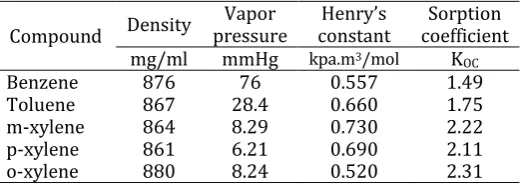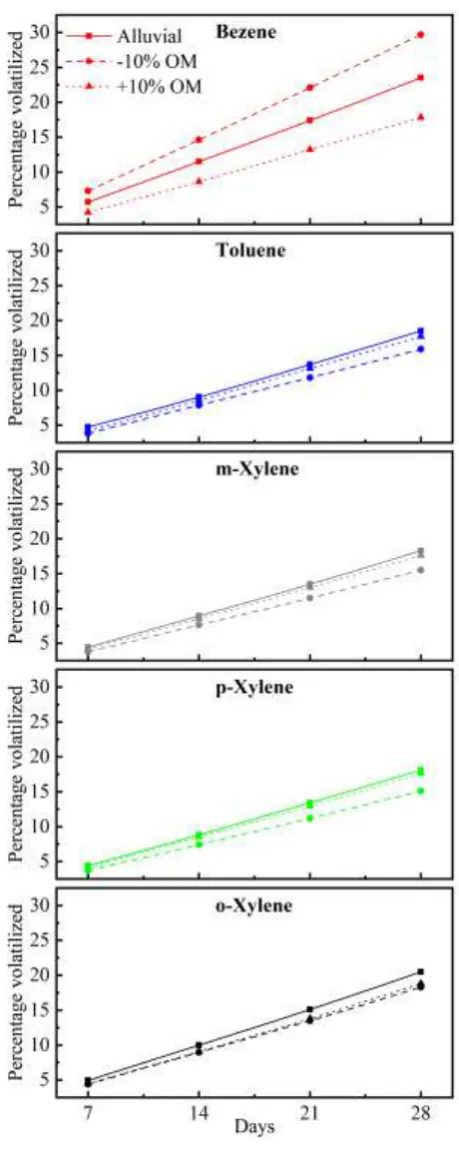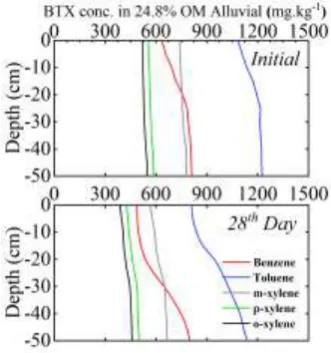© 2019, IRJET | Impact Factor value: 7.211 | ISO 9001:2008 Certified Journal | Page 990
Impact of Organic Matter on Volatilization of Petroleum VOCs from
Soil Columns
Shahul Hameed K.P
1, Sadashiva Murthy B.M
21
Research Scholar, Department of Environmental Engineering, SJCE, Mysuru-06, Karnataka, India
2Professor, Department of Environmental Engineering, SJCE(JSSS&TU), Mysuru-06, Karnataka, India
---***---Abstract -
Contamination of fertile soils by disposal widerange of chemical toxic volatile effluents have become a major threat to subsoil ecosystem and groundwater. The long-term persistence of such chemicals is greatly influenced by soil properties, mainly the organic content which enhance the sorption of such compounds in soil. Series of soil columns packed with alluvial soils of variable organic content were used to investigate the influence of soil organic matter (SOM) on rate of volatilization of petroleum Benzene, Toluene and Xylenes (BTX) were studied for a duration of 28 days. The soil used for study was silt loam with high porosity and soil organic matter (SOM). The initial examination of soil columns prior to volatilization showed 12% excess contaminants in +10% organic content amended soil as compared to normal alluvial soil. All the sampling and analysis was carried out as per standard procedures recommended by USEPA Methods 5035 and 8021b. The weekly gaseous phase volatilization of BTX showed maximum rates for benzene characterized by drastic change in contaminant profiles in all soils irrespective of organic content due to its superior vapor pressure. Similar conditions for toluene and xylenes showed 1-3% fluctuation in volatilization at variable organic content. The 4-week study showed that, a difference in 20% OM affected 1.66 times lower rates for benzene and for other compounds it varied ~1.1 times.
Key Words: Contaminants, Subsoil, Groundwater, BTX, Soil
organic matter, Volatilization, USEPA.
1. INTRODUCTION
Soil is the prime element that support life on earth. Human beings have modified the landscape and character of soil to meet his needs. Among them is the unscientific disposal and accidental spillages of toxic chemicals. Study on gaseous phase transport or volatilization of toxic compounds and the factors governing this process is significant in determining the vapor intrusion from contaminated sites and for devising remediation measures. The classical case of Love canal episode and related health and regulatory issues serve as a benchmark example for such scenario [1].
The persistence of VOCs in subterrestrial environment is greatly influenced by soil and contaminant properties. Among the soil properties, soil organic matter is an important factor for retention of VOCs. Hence, detailed
laboratory soil column studies were conducted for alluvial and SOM amended soils to determine the impact of organic matter on volatilization of petroleum BTX. The sorption capacity specific to chemical compounds are further affected by the presence of organic matter in soil mass. Among chemical characteristics of BTX, its density, vapor pressure and sorption capacity govern the gaseous phase transport from soil.
1.1 Petroleum BTX
[image:1.595.305.566.483.576.2]BTX belongs to the aromatic group of petroleum compounds and are also known as Light Non-Aqueous Phase Liquids (LNAPL) because of low density and vapor pressure. For this reason, these compounds are called “aromatic compounds.” Many of these compounds contain a benzene ring that is bound to one or more substituents which gives sweet odor. Much of these compounds are carcinogenic and has severe health implication if contacted by dermal, inhalation or ingestion. Table 1 presents the key chemical characteristics governing volatilization of BTX [2].
Table 1. Key characteristics of BTX
Compound Density pressure Vapor constant Henry’s coefficient Sorption mg/ml mmHg kpa.m3/mol KOC
Benzene 876 76 0.557 1.49
Toluene 867 28.4 0.660 1.75
m-xylene 864 8.29 0.730 2.22
p-xylene 861 6.21 0.690 2.11
o-xylene 880 8.24 0.520 2.31
-© 2019, IRJET | Impact Factor value: 7.211 | ISO 9001:2008 Certified Journal | Page 991
102 kPa and non-volatiles are <10-5 kPa [4]. Volatilecompounds of gasoline are potential air pollutants at higher concentrations of vapor above the liquid phase. Leakage from underground storage tanks result in upward vapor phase transport. Review on transport of VOCs in environment has indicated that the vapor pressure plays a key role which governs the rate of transport of organic chemical contaminants [5]. A study on volatilization rates of gasoline from subsoil showed that it drastically increased at higher vapor pressures [6].
1.2 Soil organic matter
It is the organic material which may be natural, thermally transformed, biologically derived present in soil or on the surface regardless of the sources excluding the portion of living plants above the ground [7]. The major elements of organic matter are N(3.7-4.1%), H(3.3-4.8%), O(34-39%) and C(52-58%) [8]. SOM may be non-humic and humic organic substances [9].
SOM’s are 5% while in soft top soils and >1% in sandy soils [8],[9],[10]. Even at such minimum amounts, it is highly reactive and has major effect on physico-chemical characteristics of soil. Factors governing soil formation such as time, climate, vegetation, parent material and topography influence the mass of SOM in soil. SOM is gathered in soils at different rates variable quantities. Research on sorption of contaminants on soil particles revealed significant dependency of soil physical and chemical properties on SOM. Thus, it is significantly in deciding sorption of organic compounds and strongly govern contaminant leaching, biodegradability and volatility. Hence, the need to understand the degree of significance of SOM on sorption of petroleum VOCs are paramount. The soils amended with excess SOM to have shown enhanced sorption of contaminants because of its superior specific surface-area and cation exchange capacity. Even though, SOM is the primary soil component governing sorption of contaminants, clay fractions also contribute to this process [8]. The total sorption of nonpolar organic contaminants on organic and mineral particles was investigated, and the research showed that their influence was dependent on mineral properties like area, pore geometry, intrinsic sorptive attraction of mineral surface and characteristics of compounds such as water repulsion and solubility [11],[12],[13].
The non-humic compounds exist soil for short duration, and comprises of proteins, peptides, carbohydrates, fats, waxes, low molecular weight acids and amino acids [8]. The humic SOM’s are the most principal elements of soils and comprises of humic-fulvic acids and humin. Compared to humic acid, fulvic have abundant carboxylic and phenolic groups and hydrogen/carbon and oxygen/carbon atomic ratios. This reduction of humic, fulvic acids and humin indicates the biodegradation order of humin, starting with decay of non-amorphous organic matter into humic acids and progress to fulvic acids and finally becomes humin [9].
Their distinctive composition and related functional groups greatly impact sorption of petroleum VOCs.
There are two kinds of SOM which has different physical and chemical properties and are made of soft carbon or amorphous SOM like humic matter and hard carbon. Sorption of hydrophobic organic compounds, like gasoline on amorphous SOM leads to linear partitioning whereas sorption on hard carbon SOM showed adsorption as well as absorption [14]. Therefore, depending on its relative presence, these two SOM phases in soil may result in linear separation to highly nonlinear adsorption of hydrophobic organic compounds. Also, SOM diverges in oxygen/carbon atomic ratio and its reduction results in increases of hydrophobic property and water repulsive force for sorption. The physicochemical properties of various types of SOM are significantly related to rate of desorption and sorption [15],[16].
2. Experimental Methodology
The physical and chemical properties of alluvial soils were anaylsed as per IS methods to determine bulk density, moisture content, pH, porosity, specific gravity, cation exchange capacity and texture. However, such test was not necessary for amended soils since, SOM were the only variables apart from other properties.
The BTX volatilization studies were carried out in 10 cm diameter clear Perspex columns of 60 cm deep with 50 cm soil depth. The soil columns were filled with alluvial soil and 2 organic matter amended alluvial soils of +10% and -10% SOM. A total of 12 soil columns were used which were pre-contaminated with vehicular grade petrol which contains BTX (Benzene-Toluene-Xylenes). The SOM in alluvial soils were modified by adding dry powdered leaves to add 10% organic matter and reduction was done by heating the alluvial soil by oven drying the samples at 95°C for 1186 min. The soil columns were pre-contaminated with a known amount of vehicular grade petrol and allowed to drain out for 24hrs before volatilization studies. The soil columns were exposed to ambient temperature for 4 weeks and a batch of 3 columns with three different set of SOM alluvial soils were analyzed at an interval of 1 week. The soil samples were drawn at an interval of 5cm deep using a pre-slit stainless steel core sampler which amounts to a total of 11 samples per column (i.e., 33 for soils) per week.
© 2019, IRJET | Impact Factor value: 7.211 | ISO 9001:2008 Certified Journal | Page 992
BTX volatilization, contaminant profiles in soils of variableSOM. Based on differences in chemical properties of BTX, the variation in rates among the compounds were analyzed.
3. Results
[image:3.595.317.547.134.711.2]The physico-chemical analysis of alluvial soils indicated that the soil type was silt loam with high porosity and SOM at 38.44% and 14.8 % respectively with other parameters being 1.424 g/cc (In-situ density), 6.90 (pH) and 16.50 meq (CEC). High porosity helps retaining higher mass of contaminants. Since the SOM in alluvial soils were modified, it resulted in variable contaminant levels in soils of similar physical properties other than SOM. The variable contaminant retention the pre-contaminated alluvial soil columns were initially analyzed for BTX and the mass of contaminants retained are presented in Table 2.
Table 2. Initial BTX concentration in soil columns Soil Benzene Toluene m-X p-X o-X Alluvial 36876 58118 37260 27965 26125 Alluvial
(+10%OM) 41301 65092 41731 31321 29260 Alluvial
(-10%OM) 33188 52306 33534 25169 23512
Among BTX, it may be observed that the concentration of Toluene was maximum followed by m-xylene, benzene, p and o-xylene respectively. This initial pollutant levels in soil are mainly governed by their concentrations in the leaked contaminant, where Toluene was the abundant compound at 41269.2 mg/L which was 1.58 times higher than benzene followed by 1.588, 2.12 and 2.26 times of xylenes (m-p-o). However, m Xylenes showed higher initial concentration than benzene due to its higher soil sorption capacity. Among the soils, +10% OM amended soils showed maximum BTX amounting to higher organic content which resulted in 12% higher BTX levels than normal alluvial soils. Similarly, -10% OM soil showed 10% lower initial concentrations of BTX in soil columns.
The ambient conditions during the 4-week study period was recoded as, maximum and minimum ranged between 17 C to 31.9 C with an average observed of 25 C. Throughout the study period, the temperature fluctuated around 23 C to 25 C indicating there were no extreme anomaly in temperatures.
The loss of benzene due to vapor phase was observed to be maximum among the BTX compounds. The weekly loss of benzene greatly reduced in +10% OM by 5.7% as compared to normal soil. The rate was observed to increase by 6.2 % in -10% OM soils for 28th day. The average rate of losses was 14.52% in normal soil, 18.42% for -10 % OM soil and 10.96% for +10% OM soils respectively. For other compounds such as toluene and isomers of xylene, the difference in percent loss by volatilization showed very little variation for variable OM at 1-3% at 28th day. A closer look into the chemical characteristics show that the superior vapor pressure of
benzene over other compounds acts as a driving force for the vapor phase migration from all soils, even though the OM is retarding the volatilization.
Fig 1. Percent reduction in BTX volatilization for alluvial soils of variable organic matter
[image:3.595.34.289.301.396.2]© 2019, IRJET | Impact Factor value: 7.211 | ISO 9001:2008 Certified Journal | Page 993
an increase in 10% SOM in alluvial soil showed 25.08%reduction in volatilization of benzene. The reduction in loss for other compounds were observed as 4-9%. It indicates that level of SOM greatly influences the vapor phase mobility of petroleum benzene from alluvial soil. These observations show the significance of organic matter in sorption of volatile compounds in soil for longer time period as reported in previous studies [8],[19]. Further investigations carried out to study the influence of SOM on retardation of vapor phase migration of BTX showed considerable variations at higher and lower soil organic matter. However, the difference in vapor phase loss of between individual compounds in BTX was within 1%.
The concentration profiles of BTX across a depth of 50 cm showed drastic variations in benzene and toluene for all soils as shown in Fig 2, 3 and 4. The change in concentrations were rapid upto a depth of 20 cm because of sufficient aeration in the top soil layer. The profiles for variable OM showed similar trends with different concentrations. The profiles of xylenes showed very minimal variations due to its lower vapor pressure coupled with stronger soil sorption capacity.
Fig 2. BTX Concentration profiles in alluvial soil
Fig 3. BTX Concentration profiles in +10% OM alluvial soil
Fig 4. BTX Concentration profiles in +10% OM alluvial soil
The volatilization rate of benzene at the end of 28th day in alluvial soil and +10% SOM soils were 20% and 36% lower at 309.36 and 263.44 mg/day than toluene. In -10% SOM soil, the rates were 15% higher for benzene at 352.75 mg/day as compared to toluene. This shows the affect of SOM on vapor pressure of benzene which is 2.67 times greater than that of toluene.
4. CONCLUSION
In the initial part of soil column studies, soils with higher SOM content showed higher contaminant retention with toluene as most abundant compound in soil due to its higher initial concentration in leaked petroleum fuel followed by xylenes due to their higher sorption capacity. The study also showed significant impact of SOM on volatilization of petroleum BTX from alluvial soils. It affected 12% reduction in the vapor phase transport of benzene in organic rich soils as compared to -10% SOM soils. It induced competitive volatilization between benzene and toluene in high SOM soils by 20% and 36 %, even though benzene has superior vapor pressure than the latter compound. As opposed to rapid volatilization of benzene, compounds such as toluene and xylenes showed lower rates of vapor phase losses from soil mass mainly due to their lower vapor pressure and better soil sorption capacities. This was further substantiated by soil contaminant profiles which indicated minor variations in concentration trends for these compounds.
ACKNOWLEDGEMENT
[image:4.595.345.513.101.277.2] [image:4.595.84.250.347.520.2] [image:4.595.76.242.554.731.2]© 2019, IRJET | Impact Factor value: 7.211 | ISO 9001:2008 Certified Journal | Page 994
REFERENCES
[1] Department of Health. Love Canal: A special Report to
the Governor & Legislature. New York, 1981.
[2] D. Mackay., K. Ma., S. Chi Lee., W. Ying Shiu. Handbook of
Physical-Chemical Properties and Environmental Fate for Organic Chemicals, Second Edition, Chemphyschem A European Journal of Chemical Physics and Physical Chemistry. 2006. https://doi:10.1201/9781420044393
[3] E. Baum. Chemical Property Estimation. CRC Press.
2018. https://doi.org/10.1201/9781315139159
[4] D.A. Vallero. Environmental contaminants: assessment and
control. Elsevier Academic Press. 2004.
[5] D. Mackay, F. Wania. Transport of contaminants to the
Arctic: partitioning, processes and models. Sci. Total
Environ. 160–161, 1995, 25–38.
https://doi.org/10.1016/0048-9697(95)04342-X
[6] P. Arthurs, W.H. Stiver, R.G. Zytner. Passive volatilization
of gasoline from soil. J. Soil Contam. 4, 1995, 123–135. https://doi.org/10.1080/15320389509383487
[7] P.M. Huang, Y. Li, M.E. Sumner. Handbook of soil
sciences: properties and processes. CRC Press. 2012.
[8] D.L. Sparks. Environmental Soil Chemistry. Elsevier.
2003. https://doi.org/10.1016/B978-0-12-656446-4.X5000-2
[9] S.K. Basu, M. Asif. Review of Environmental Soil
Properties and Behaviour. J Agric Food Inf 15, 2014, 74– 74. https://doi: 10.1080/10496505.2014.863128
[10] R.N. Yong, Geoenvironmental engineering: contaminated
soils, pollutant fate and mitigation. CRC Press. 2001.
[11] G. Fleury, M. Del Nero, R. Barillon. Effect of mineral
surface properties (alumina, kaolinite) on the sorptive fractionation mechanisms of soil fulvic acids: Molecular-scale ESI-MS studies. Geochim. Cosmochim. Acta 196, 2017, 1–17. https://doi.org/10.1016/j.gca.2016.09.029
[12] J.C. Joo, C.D. Shackelford, K.F. Reardon. Sorption of
nonpolar neutral organic compounds to humic acid-coated sands: Contributions of organic and mineral components. Chemosphere 70, 2008, 1290–1297. https://doi.org/10.1016/j.chemosphere.2007.07.052
[13] G. Wu, X. Zhu, H. Ji, D. Chen. Molecular modeling of
interactions between heavy crude oil and the soil organic matter coated quartz surface. Chemosphere 119, 2015,242–249.
https://doi.org/10.1016/j.chemosphere.2014.06.030
[14] W.J. Weber, P.M. McGinley, L.E. Katz. A distributed
reactivity model for sorption by soils and sediments. 1. Conceptual basis and equilibrium assessments. Environ. Sci. Technol. 26, 1992, 1955–1962.
https://doi.org/10.1021/es00034a012
[15] W. Huang, P. Peng, Z. Yu, J. Fu. Effects of organic matter
heterogeneity on sorption and desorption of organic contaminants by soils and sediments. Appl. Geochemistry, 18, 2003, 955–972.
https://doi.org/10.1016/S0883-2927(02)00205-6
[16] Z. Wang, S. Chen, Y. Xu, J. Tang. Aging effects on
sorption–desorption behaviors of PAHs in different
natural organic matters. J. Colloid Interface Sci. 382, 2012,117–122.
https://doi.org/10.1016/j.jcis.2012.06.003
[17] USEPA, 1996. 5035 Closed system purge-and-trap and
extraction for volatile organics in soil and waste samples, in: SW-846 On-Line. pp. 1–24.
[18] USEPA, 2013. Aromatic and halogenated volatiles by gas
chromatography using photoionization and/or electrolytic conductivity detectors, in: Method 8021B. pp. 1689–1699.
https://doi.org/https://www.epa.gov/hw-sw846/sw- 846-test-method-8021b-aromatic-and-halogenated-volatiles-gas-chromatography-using.
[19] S.W.C. Chien, S.H. Chen, C.J. Li. Effect of soil pH and
organic matter on the adsorption and desorption of pentachlorophenol. Environ. Sci. Pollut. Res. 25, 2018, 5269–5279.


